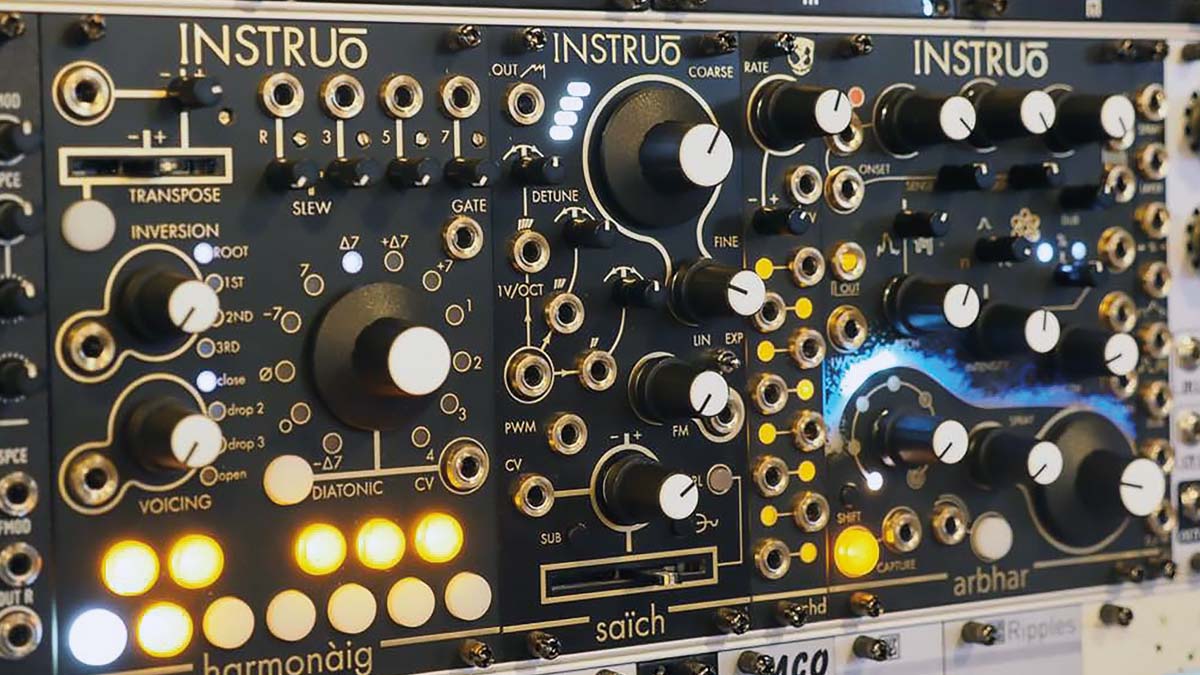MusicRadar Verdict
They can be used as standalone modules but make for some very interesting musical possibilities when used together. Saïch is an excellent four-voice VCO, while the Harmonàig offers an intuitive, fresh spin on polyphonic output.
Pros
- +
Core sounds are top notch.
- +
But both modules really excel when used together.
- +
CV controllable PWM.
- +
Good-looking modules and well-built.
Cons
- -
Not much.
MusicRadar's got your back
What is it?
Although these two modules are completely standalone we’ll review them as a matched pair, seeing as they work so well together and we're pretty sure that the Saïch was designed to complement the Harmonàig.
To top that off, they look great next to each other in a rack, with the added benefit of short cables needed for what could well be a near-permanent connection.
We'll kick things off with a look at the Harmonàig, an 18hp module which has rapidly become a community favourite for quantising. With the new gold on black Instruo livery, it certainly looks the part.
There’s a heft to Instruo gear that inspires confidence in build quality without making you worry about dragging your rig to gigs.
The Harmonàig can take an input voltage from pretty much any source (we prefer sample and hold, sequencer outputs or even simple LFOs) which it then processes to provide an output voltage which, when plugged into the volt per octave of a sound source means you have controlled pitch. So far so normal. What the Harmonàig does is a bit special…
Performance and verdict
It's not quite polyphonic in the traditional sense but the Harmonàig does mean you can now play chords, assuming you have voices to spare. You can route your root, 3rd,5th and 7th to individual voices. Or, if you want to play modular power chords, just the root and 5th, or any other combination of notes.
The slider up top allows for global transposition, as well as help with other functions. There are various modes and button combos to dig into extra functionality but there’s not space to cover all those here.
Want all the hottest music and gear news, reviews, deals, features and more, direct to your inbox? Sign up here.
What makes the Harmonàig special is how it becomes a truly musical tool, even for users with little (or no) theory knowledge. There are two controls to the left that let you dial in the chord voicings and inversions. You don’t need to know what this means to get great results from them.
On top of that they both take CV so you can modulate them for added musical complexity, spacing out your virtual fingers on the virtual keyboard (that's what the voicing section does). The big knob to the right is where you further define the feel or mood, so give it a twist or add CV to spice up your chords.
We’ll move on to the Saich in a minute but have a quick think about what the Harmonàig does for a second. It provides a polyphonic output which is very well suited to creating chord progressions, with voice complexity.

• Instruo Cš-L
The panel layout and routing is a bit challenging but if we could only have one oscillator in our system we’d be happy if it was this one.
• Erica Synths Fusion System II
With bags of personality and sonic opportunity on offer, Erica Fusion will deliver endless experimentation and, most importantly, fun.
It does this by splitting the output across four channels, each with a physical output, so what you can also do is drive four totally different sound sources with it.
You could easily set a different voice for the bass and send the others elsewhere (or all to separate), meaning you can set up complementary voices for each note (assuming you tune each voice properly – the Harmonàig has a handy tool for that too).
Get Saïched up
So on to the Saïch, a four-voice VCO made as the dream partner to the Harmonàig, although it can obviously be paired up with other modules. This is another tool that has some hidden functionality, but for now, I’ll just cover the top-level stuff. The triangle cores all have their own volts per octave input and detune knobs, with global pitch having a coarse and fine-tuning control.
The cores have CV controllable PWM for adding a little movement to your voices, as well as there being a sub out, so you can really get things thick and creamy. On top of this, there’s an FM input, with both CV and knob control, which can be set to linear or exponential.
These cores sound great, with a lot of versatility in sound shaping. As a four-voice VCO in its own right, Saïch is a winner… Where these two really shine is together. They make a great pairing, with many features and options I don’t have space to cover.
Rest assured, the Harmonàig and Saïch play well on their own but as musical siblings, they shine. Never has it been truer than the sum of the parts are greater than the whole. Whether you have musical chops or you live in the land of bleeps and bloops you won’t go wrong with these two.
MusicRadar verdict: The Harmonàig and Saïch can be used as standalone modules but make for some very interesting musical possibilities when used together. Saïch is an excellent four-voice VCO, while the Harmonàig offers an intuitive, fresh spin on polyphonic output.
Hands-on demos
Instruo
DivKidVideo
Specifications
- TYPE: Four-voice voltage quantiser (Instruo Harmonàig £300), quad oscillator (Saïch £469)
- KEY FEATURES: Harmonàig creates polyphonic output for chord progressions; Saïch has super-saw functionality and built-in “smart” VCA mixing, paraphonic patching in analogue
- CONTACT: Instruo
